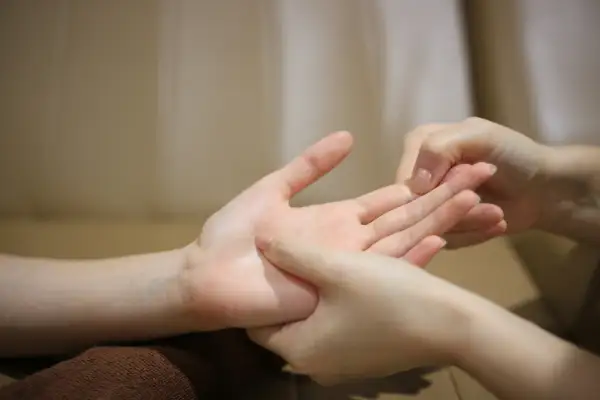How can dealing with pain and sensory symptoms affect the daily life of people with multiple sclerosis?
How can the symptoms be reduced and the quality of life improved?
The answers are in the article in front of you.

People with MS often report sensory symptoms and pain. For some people these are the first symptoms they notice 1 .
The sensory symptoms and pain can be episodic, but are usually chronic and persist or recur frequently for six months or more. Their duration and intensity vary from person to person and during the course of the disease. Some will experience them as severe, but the majority will experience them as mild to moderate 1 .
Since multiple sclerosis can affect different areas of the nervous system, the symptoms vary from person to person and in the same person, during the course of the disease. Sensory symptoms include:
- Skin sensations such as tingling, itching, tingling, tickling, heat or cold 1.
- Complete or partial numbness . The numbness can be in a small area of the body, such as a certain area of the face or in large areas, such as the legs, hands or feet 1.
- Visual symptoms such as blurred, hazy vision or double vision caused by damage to the optic nerve 2.
- Pain is usually focused in the area of the legs, arms or feet. The pain can be as a result of the nerve damage of the disease (neuropathic pain), which is usually described as a “burning” pain, or secondary pain resulting from other problems such as spasticity, load on the joints or medication. In addition, sometimes there is a pain known as Lhermitte’s sign, which is a sudden and sharp pain that goes down the neck, back and limbs, and is triggered by moving the head forward or backward, as well as pain known as “multiple sclerosis hug”, which is a feeling of pressure around the chest or abdomen 3.
The effect of sensory disorders on daily life
In some cases the sensory symptoms are a nuisance and do not significantly affect the routine. In others, however, they may affect the routine, especially if they are experienced frequently and with high intensity. A sensation disorder in the face, for example, may cause tongue biting while eating or mouth burns from hot drinks; Disturbance of sensation in the hands may interfere with writing, dressing and handling objects in a safe manner 1 ; Vision problems may affect the ability to read, drive and walk 2 . Sensory disorders can also cause motor disorders, since the sensory information needed to control the movement does not reach the brain, and thus, for example, a sensation disorder in the legs can cause an unstable walk and increase the risk of falling 4 .
Video: “Rehabilitation of the patients with Multiple Sclerosis”
Multiple Sclerosis. Exercises for stretching and improving body flexibility and joint mobility, reducing tone.
For additional information about Rehabilitation of the patients with Multiple Sclerosis you can watch a video demonstrating exercises and rehabilitation recommendations.
The effect of pain on daily life
Pain may impair a person’s ability to perform basic and complex daily activities, as well as cause avoidance of activities such as work, social life, leisure activities and fulfillment of social roles (spouse, parent, friend). Pain can also impair the quality of sleep and cause fatigue, which in turn impairs the performance of daily activities. It may lead to a decrease in mood, the feeling of being alive and enjoying life. People with sclerosis report that pain causes social isolation because of the feeling that others do not understand their pain, so they avoid talking about it 3 .
Management of sensory symptoms and pain
It is important to talk about the sensory symptoms and the pain with the doctor and the treating team for diagnosis. In this way, you can build a personalized program and try to improve function and quality of life 1,3 .

A treatment plan usually combines several strategies:
- Drug treatment . After the causes and degree of severity of the symptoms have been diagnosed, drug treatment can be examined to alleviate some of the symptoms. Not all symptoms can be treated with medication.
- Complementary treatments . Treatments such as electrical stimulation, heat and cold treatments, reflexology, acupuncture, and therapeutic massage. It is important to consult a doctor about these treatments and contact qualified professionals 1,3.
- Avoiding triggers . If the sensory disturbances and pain are caused by different triggers such as touch, heat or wind, it is recommended to try to reduce the exposure to the triggers. For example, it is possible to reduce pain caused by the contact of coarse cloth on the skin or by the body heating up by wearing ventilated clothes 1.
- Function-focused practice . When the daily functions are impaired as a result of the sensory problems and the pain, it is possible to work with a physical therapist and/or an occupational therapist on specific strategies to perform actions that will alleviate the symptoms as much as possible 1 .
- Use of accessories . There are a variety of accessories that can help, for example cutlery or thickened writing instruments, which can help those who suffer from sensory problems with their hands; walking sticks and walkers, to assist walking due to sensory problems in the legs; Vision accessories such as magnifying glasses and adapted lighting, and more. Qualified professionals should be consulted in choosing the most suitable accessories for you 2.
- Physical activity . People with MS tend to avoid participating in physical activity for fear that it will make their symptoms worse, but research shows that there are many benefits to participating in physical activity. Activity adjusted by a professional can help reduce pain and sensory disturbances, reduce the risk of falls, and improve fatigue, mood and sense of self-efficacy 3,5.
- Behavioral treatments to reduce pain . Cognitive behavioral therapy (CBT) for pain reduction focuses on cognitive (mental) techniques, such as identifying and reducing negative thoughts that cause hypervigilance and increasing symptoms, as well as behavioral techniques, such as muscle relaxation, guided imagery and diaphragmatic breathing. Mindfulness therapy focuses on developing non-judgmental awareness, accepting the present moment, and the feelings, sensations and thoughts that accompany this moment. These two treatments may reduce the intensity of the symptoms and their physical and emotional impact 3 .
- Sharing with relatives . Sharing with your relatives is especially important because most of the time these symptoms are transparent and cannot be detected by them. Your relatives do not necessarily understand what their consequences are for your routine, mood and quality of life. Sharing can also prevent a feeling of loneliness and help others know how to help you when you experience these symptoms.
In conclusion, the sensory symptoms and dealing with the pain may affect the daily life of people with multiple sclerosis. Along with this, using the strategies presented in this article may reduce the intensity of symptoms and improve the quality of life of people with multiple sclerosis.
The author: Dr. Yifa Arbel (PhD), occupational therapist.
Sources:
- MS Australia. Symptoms: Sensory symptoms, 2021; 1–5
2. Nastasi et al. 2012. Multiple Sclerosis Rehabilitation. 247–273
3. Ehde et al. 2012. Multiple Sclerosis Rehabilitation. 199–227
4. Bethoux et al. 2012. Multiple Sclerosis Rehabilitation. 135–160
5. Razazian et al. 2016. Med Sci Sport Exerc; 48: 796–803.

Check out the demo version of our sets of exercises for Multiple Sclerosis on YouTube
You can find more information about Multiple Sclerosis in our Library of Articles.
Our website presents the following sets of exercises for the rehabilitation of the patients with Multiple Sclerosis:






Thanks for the informative and helpful article.